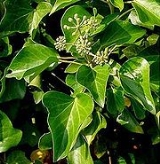
Hedera hibernica
Encyclopedia

Ivy
Ivy, plural ivies is a genus of 12–15 species of evergreen climbing or ground-creeping woody plants in the family Araliaceae, native to western, central and southern Europe, Macaronesia, northwestern Africa and across central-southern Asia east to Japan and Taiwan.-Description:On level ground they...
(genus Hedera) which is native to the Atlantic coast of Europe
Europe
Europe is, by convention, one of the world's seven continents. Comprising the westernmost peninsula of Eurasia, Europe is generally 'divided' from Asia to its east by the watershed divides of the Ural and Caucasus Mountains, the Ural River, the Caspian and Black Seas, and the waterways connecting...
. Its common names are the Atlantic Ivy or Irish Ivy.
Overview
It is an evergreenEvergreen
In botany, an evergreen plant is a plant that has leaves in all seasons. This contrasts with deciduous plants, which completely lose their foliage during the winter or dry season.There are many different kinds of evergreen plants, both trees and shrubs...
climbing plant, growing to 20–30 m high where suitable surfaces (tree
Tree
A tree is a perennial woody plant. It is most often defined as a woody plant that has many secondary branches supported clear of the ground on a single main stem or trunk with clear apical dominance. A minimum height specification at maturity is cited by some authors, varying from 3 m to...
s, cliff
Cliff
In geography and geology, a cliff is a significant vertical, or near vertical, rock exposure. Cliffs are formed as erosion landforms due to the processes of erosion and weathering that produce them. Cliffs are common on coasts, in mountainous areas, escarpments and along rivers. Cliffs are usually...
s, wall
Wall
A wall is a usually solid structure that defines and sometimes protects an area. Most commonly, a wall delineates a building and supports its superstructure, separates space in buildings into rooms, or protects or delineates a space in the open air...
s) are available, and also growing as ground cover where there are no vertical surfaces. It climbs by means of aerial rootlets which cling to the substrate. Native from the Atlantic region, it has been cultivated and can appear in wild outside its original area, along the Atlantic coast from Portugal, Spain, France, British Isles, Germany, Scandinavian countries, and baltic sea.
The climbing woody stems up to 20 m, based on the support by means of adventitious roots that not parasitize the tree support.Irish Ivy has tender and very large dark green leaves that have five points.
The plant has an attractive and elegant aspect. It is quite common in gardening. H. hibernica, like the related H. helix (English Ivy), is a invasive
Invasive species
"Invasive species", or invasive exotics, is a nomenclature term and categorization phrase used for flora and fauna, and for specific restoration-preservation processes in native habitats, with several definitions....
weed in parts of North America with mild winters.
Irish ivy (Hedera hibernica) is an evergreen vine with a creeping, climbing growth form. The bark is first green, but soon after it becomes gray. Old branches are light gray with a finely furrowed bark. Buds are almost hidden by leaf base, egg-shaped and bright green. The leaves have entire margins and are ovoid or with five triangular lobes. The surface is glossy dark green with light ribs, while the underside is pale green. The leaves of flowering shoots is, however, oval with entire margins. Flowering occurs in September-October, where to find the flowers together in spherical crowns that are part of big end off and open clusters in particular, shrub-like shoots. The fruits are blue-black berries.
Non-visible features: The plant has two kinds of roots: the ordinary into the ground and a special climb up towards the roots of the objects, the plant climb. Climbing roots are close together on the side of the branch, which faces the substrate. The whole plant and also the berries are slightly poisonous.
Irish ivy is used as an alternative to the related Common ivy (Hedera helix). Both species are classified as invasive in parts of North America, who have mild winters.
Ecology
It may be a noxious weed or be invasiveInvasive species
"Invasive species", or invasive exotics, is a nomenclature term and categorization phrase used for flora and fauna, and for specific restoration-preservation processes in native habitats, with several definitions....
. It requires consistently moist soil, grow to full sun or in dark shade. The natural habitat is forest or dense bush which are cloud-covered for much of the year, where the dense moisture
Moisture
Humidity is the amount of moisture the air can hold before it rains. Moisture refers to the presence of a liquid, especially water, often in trace amounts...
from the sea or ocean, is precipitated by the action of the relief, causing it to condense part of the moisture that falls as rain or fog, creating an habitat especially cool, saturated with moisture in the air and soil, with annual oscillation of the temperature moderated by the proximity of the ocean.
Prefers well-drained or alkaline soils rich in nutrients and humus with good water provision, but is adapted in any wet land. Appears in streams, in coastal mountains, favorite distribution in humid microclimates, that is, such as cloud forest
Cloud forest
A cloud forest, also called a fog forest, is a generally tropical or subtropical evergreen montane moist forest characterized by a persistent, frequent or seasonal low-level cloud cover, usually at the canopy level. Cloud forests often exhibit an abundance of mosses covering the ground and...
, stream valleys, and refugees in microenvironments favorable climate, in the coastal mountain ranges.

